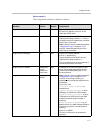
Administrator’s Guide SoundPoint IP / SoundStation IP
A - 4
CONFIG_FILES=”phone1[MACADDRESS].cfg, sip.cfg” MISC_FILES=””
LOG FILE DIRECTORY=”” OVERRIDES_DIRECTORY=””
CONTACTS_DIRECTORY=”” LICENSE_DIRECTORY=””/>
If you have a requirement for separate application loads on different phones
on the same boot server, you can modify the application that is loaded when
each phone reboots. An example is below:
<?xml version=”1.0” standalone=”yes”?>
<!-- Default Master SIP Configuration File -->
<!-- edit and rename this file to <Ethernet-address>.cfg for
each phone. -->
<!-- $RCSfile: 000000000000.cfg,v $ $Revision:$ -->
< APPLICATION APP_FILE_PATH=”[PHONE_PART_NUMBER].sip.ld”
CONFIG_FILES=”phone1.cfg, sip.cfg” MISC_FILES=””
LOG FILE DIRECTORY=”” OVERRIDES_DIRECTORY=””
CONTACTS_DIRECTORY=”” LICENSE_DIRECTORY=””/>
You can also use the substitution strings PHONE_MODEL,
PHONE_PART_NUMBER, and PHONE_MAC_ADDRESS in the master
configuration file. For more information, refer to Product, Model, and Part
Number Mapping on page C-26.
You can also direct phone upgrades to a software image and configuration
files based on the phone model number and part number. All XML attributes
can be modified in this manner. An example is below:
<?xml version=”1.0” standalone=”yes”?>
<!-- Default Master SIP Configuration File -->
<!-- edit and rename this file to <Ethernet-address>.cfg for
each phone. -->
<!-- $RCSfile: 000000000000.cfg,v $ $Revision:$ -->
<APPLICATION APP_FILE_PATH=”sip.ld” CONFIG_FILES=”phone1.cfg,
sip.cfg” MISC_FILES=”” LOG_FILE_DIRECTORY=””
OVERRIDES_DIRECTORY=””
CONTACTS_DIRECTORY=”” LICENSE_DIRECTORY=””
APP_FILE_PATH_SPIP300=”SPIP300.sip.ld”
CONFIG_FILES_SPIP300=”phone1_SPIP300.cfg, sip_SPIP300.cfg”
APP_FILE_PATH_SPIP500=”SPIP500.sip.ld”
CONFIG_FILES_SPIP500=”phone1_SPIP500.cfg, sip_SPIP500.cfg” />
For more information, refer to “Technical Bulletin 35361: Overriding
Parameters in Master Configuration File on SoundPoint IP Phones“ at
http://www.polycom.com/usa/en/support/voice/soundpoint_ip/VoIP_T
echnical_Bulletins_pub.html .
Application Configuration
The configuration file sip.cfg contains SIP protocol and core configuration
settings that would typically apply to an entire installation and must be set
before the phones will be operational, unless changed through the local web


















